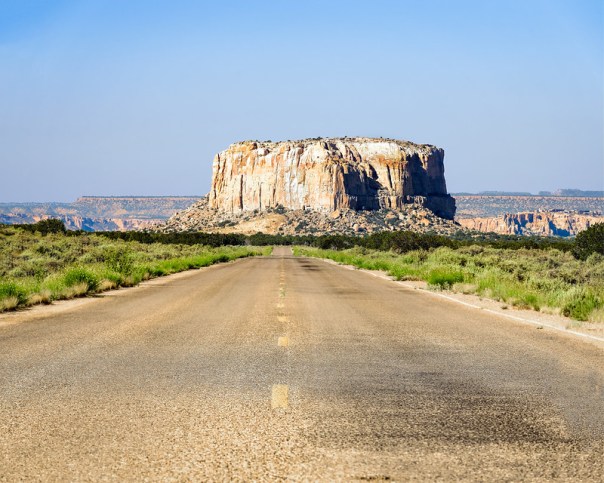MK and I went out to New Mexico for a short visit over the July 4th holiday. I’d been there several times on business travel but never got to see much of the state. This trip fixed that!
One place we very much enjoyed was the Acoma Pueblo (also known as Sky City). It’s a lovely spiritual site, and provides a glimpse into what Native American life was like as long ago as the 13th century. The Pueblo is about 60 miles west of Albuquerque – it’s a lovely drive.
 Mesa Encantada – Along Route 23 just east of Acoma Pueblo (visible in the distance on the right). According to Acoma Pueblo oral history, it was their first home before they moved to the current location.
Mesa Encantada – Along Route 23 just east of Acoma Pueblo (visible in the distance on the right). According to Acoma Pueblo oral history, it was their first home before they moved to the current location.
If you enter “Acoma Village” in your GPS, it will try to lead you up on the mesa, which you can’t get to unless you’re on a tour. Search for the visitor center instead!
 Looking up – This B&W IR view of Acoma Pueblo is from about 360 feet below, just across the highway from their visitors center
Looking up – This B&W IR view of Acoma Pueblo is from about 360 feet below, just across the highway from their visitors center
At the visitors center you can learn about the culture and history of the area. Their tour includes a bus ride to the top of the mesa and a guided walk around the pueblo. Also included in the tour price is a “photo permit” for one camera. You’ll have to buy more permits if you want to use multiple cameras. I decided to just bring my Olympus Pen F with the 24-200 mm equivalent lens and it worked for most situations on the mesa. I used the extra space in my camera bags for two bottles of water. Nice to have while walking around in the hot sun!
The horno is a traditional outdoor, wood fired oven. People were selling bread made in these ovens in the pueblo.
Even though there’s no electricity or running water up there, many of the homes on the mesa are still lived in. I liked how occasional colorful paint accents contrasted with the tan walls.
 Door and windows – One of the homes on the mesa
Door and windows – One of the homes on the mesa
Our guide told us that the Acoma adopted Catholicism from missionaries in the 1500s but they still practice their own spiritual traditions too. Although they’re very private about this, outsiders can attend celebrations during the Feast of St. Stephen(September) and at Christmas.
 Kiva – The Acoma concealed their traditional worship places inside homes and entered via a ladder through the smoke-hole in the roof.
Kiva – The Acoma concealed their traditional worship places inside homes and entered via a ladder through the smoke-hole in the roof.
As you’d expect, the views from the mesa are spectacular and the visibility is awesome.
 View north toward Mount Taylor (on the horizon, about 40 miles away). Ponderosa Pine used to build the mission was hand carried from Mount Taylor and up to the mesa.
View north toward Mount Taylor (on the horizon, about 40 miles away). Ponderosa Pine used to build the mission was hand carried from Mount Taylor and up to the mesa.
Photography isn’t allowed in the cemetery (to the left of the mission) or inside the church itself. This spot is about the best vantage point I could find.
 San Estevan del Rey Mission Church – Built between 1629 and 1641. According to Acoma oral tradition, their people were forced by Friar Juan Ramirez to build the mission.
San Estevan del Rey Mission Church – Built between 1629 and 1641. According to Acoma oral tradition, their people were forced by Friar Juan Ramirez to build the mission.
Many have photographed in Acoma and some of the images are in the public domain. It’s interesting to compare the older photos with contemporary views. Both Edward S. Curtis (in 1904-5: http://www.loc.gov/pictures/search/?q=acoma%20indians&co=ecur&sg=true) and Ansel Adams (in the 1930s and 40s: https://www.archives.gov/research/ansel-adams) photographed here. They both stood very close to the spot where I made this mission photo.
You can find more information about Acoma at these links:
- http://puebloofacoma.org
- http://www.acomaskycity.org/home.html
- https://en.wikipedia.org/wiki/Acoma_Pueblo
- http://www.legendsofamerica.com/nm-acoma.html
And I’m collecting my New Mexico images here: https://www.flickr.com/photos/edrosack/albums/72157685850604925
For those of you that are wondering why I haven’t posted any bird or wildlife photos in a while, please be patient. We did some birding while we were in New Mexico and I’m planning to blog about that next.
Thanks for stopping by and reading my blog. Now – go make some photos!
©2017, Ed Rosack. All rights reserved








































